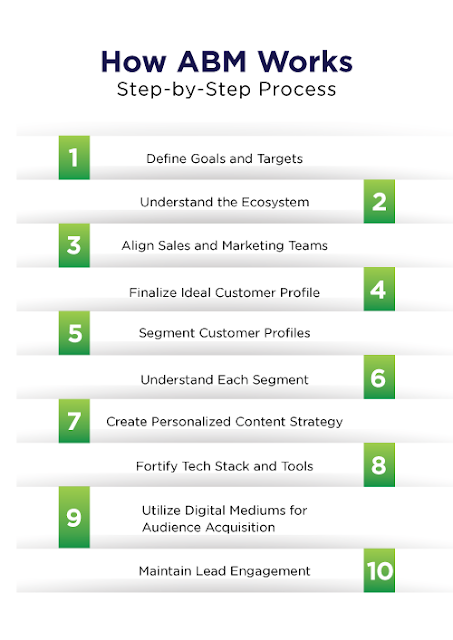Have you ever wondered how some businesses manage to turn high-value prospects into loyal clients with precision and efficiency? That’s the magic of Account-Based Marketing (ABM). Instead of casting a wide net, ABM zeroes in on high-value accounts, treating each one as a market of its own. According to a report, 91% of marketers using ABM have reported an increase in average deal size, with 208% higher revenue contribution compared to traditional marketing methods. This marketing tactic emphasizes engaging multiple stakeholders and aims to build long-term relationships with the end goal of generating revenue. Rooted in the Pareto principle, ABM ensures that 20% of your most valuable accounts contribute to 80% of your revenue.
In the professional and B2B ecosystems, ABM Marketing has proven to be an effective solution. In ABM, both the sales and marketing teams collaborate to acquire complex accounts. Setting up a mandatory framework at the initial stage is crucial to figuring out marketing efforts, resource involvement, engagement levels, and most importantly, the engagement flow.
-
Define Your Goals and Target
Define what marketing and business objectives your organization is trying to achieve with an ABM strategy. Identify key KPIs and define micro-goals. Throughout the campaign, focus on marketing cost metrics, campaign velocity, and lead qualification to monitor performance and keep the team motivated. Having clear goals ensures that all efforts are aligned towards achieving specific outcomes, such as increasing revenue, improving customer retention, or enhancing brand awareness.
-
Understanding the Ecosystem
Before entering the market, understand it thoroughly. Analyze market trends, growth drivers, and industry gaps to address challenges, needs, and opportunities. This understanding will help create an impactful value proposition. Recognize the key players, competitors, and regulatory environment in your industry. This knowledge not only aids in positioning your offerings effectively but also helps anticipate changes and adapt strategies accordingly.
-
Setting up an ABM Team for Better Coordination
Alignment between sales and marketing is crucial. Set up dedicated teams with clear objectives and regular review processes. Having ‘Reviewers or Auditors’ can enhance coordination by acting as intermediaries and ensuring both teams work effectively together. This alignment facilitates seamless communication, ensuring that both teams are on the same page regarding goals, strategies, and expected outcomes.
-
Finalizing Your Ideal Customer Profile
An ICP is a combination of firmographics, technographic, and behavioral attributes of your most catered customers. This helps in understanding which solutions to pitch or tweak. The whole team, including sales and marketing, should collaborate to finalize this profile. Defining a precise ICP enables targeted marketing efforts, ensuring resources are utilized efficiently and effectively to attract high-value customers.
-
Segmenting the Ideal Customer Profile
Creating multiple segments of ICP based on job seniority, industry, company size, geography, and funding is crucial. These buyer personas allow for optimal feedback and communication between prospects and internal teams. Segmentation helps in tailoring marketing messages and campaigns to specific audience needs, increasing the likelihood of engagement and conversion.
How ABM Works – Step-by-Step Process

-
Understanding Each Segment
A deep understanding of your audience’s needs, pain points, and triggers is essential. For instance, a CEO may be more interested in business solutions like growth or cost reduction rather than product features. Conduct thorough research and use data analytics to gain insights into each segment. This understanding helps in crafting personalized messages that resonate with each stakeholder, driving more meaningful interactions.
-
Implementing a Robust Content Marketing Strategy
Create a personalized content strategy to engage multiple stakeholders. Define a content calendar to ensure the right message is delivered at the right time, enhancing engagement rates. Develop diverse content formats such as blogs, whitepapers, case studies, and videos to cater to different preferences. A well-planned content strategy helps in nurturing leads and building trust with potential customers.
-
Fortifying Your Tech Stacks and Enlisting Third-Party Tools
Equip your teams with the right tech tools for a successful ABM program. Whether adopting an end-to-end ABM platform or integrating multiple tools, ensure your tech stack supports your ABM goals. Tools like CRM systems, marketing automation platforms, and data analytics software are crucial for tracking and managing ABM efforts. Implementing the right technology enhances efficiency, accuracy, and scalability of your marketing activities.
-
Acquiring the Target Audience Through Digital Mediums
Utilize digital mediums to reach your target audience through databases, look-alike campaigns, and IP reversal tools like Lusha. Define an engagement funnel and use remarketing strategies to acquire and nurture leads. Digital platforms provide extensive reach and targeting capabilities, allowing you to connect with the right audience at the right time. Leveraging digital marketing techniques can significantly improve lead generation and conversion rates.
-
Keeping the Leads Engaged
Maintain relationships with customers throughout their lifecycle by adopting strategies like newsletters, events, webinars, LinkedIn connections, and relevant industry content. Determine the best methods for your team and reconnect with potential leads. Continuous engagement ensures that leads remain interested and informed about your offerings, increasing the chances of conversion and customer loyalty.
Conclusion
Setting up an effective ABM framework involves meticulous planning and execution. We, at Amura Marketing Technologies, specialize in ABM-driven growth. With clients like, enParadigm, Castrol, Starkenn Technologies, Ingersoll Rand, and many more we leverage data-driven marketing approaches to deliver exceptional results. Our expertise in digital strategy, content marketing, media planning, and more ensures comprehensive support for ABM initiatives, driving growth and fostering long-term customer relationships.
Our robust methodologies and innovative solutions make us a valuable partner for businesses looking to implement or enhance their ABM strategies. Our proven track record in delivering significant business outcomes through ABM showcases the capability to support organizations in achieving their marketing and business objectives.
